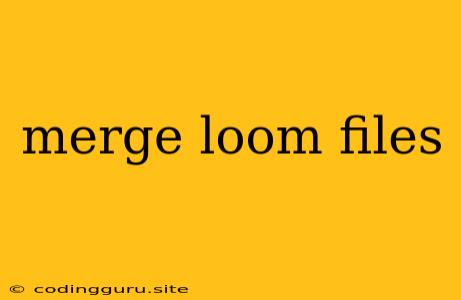Merging Loom Files: A Comprehensive Guide
Loom, a popular screen recording tool, offers a powerful way to capture and share your screen activity. But what happens when you have multiple Loom files that you need to combine into a single, coherent video? This is where merging Loom files comes in handy.
Why Merge Loom Files?
Merging Loom files can be beneficial in various scenarios:
- Combining multiple recording sessions: If you're working on a long project, you might record different parts of it in separate Loom sessions. Merging these files allows you to present a complete and seamless recording.
- Creating a comprehensive tutorial: You can break down a complex process into smaller, manageable Loom recordings and then merge them into a single tutorial.
- Sharing a series of related ideas: If you have multiple Loom files that cover related topics, merging them can provide a more organized and efficient way to share your thoughts.
How to Merge Loom Files?
Unfortunately, Loom itself doesn't offer a built-in feature for merging files. However, there are several third-party tools and workarounds you can use to achieve this:
1. Using Video Editing Software:
- Adobe Premiere Pro: A powerful and versatile video editor capable of merging multiple video files, including Loom recordings.
- Final Cut Pro: Another industry-standard video editing software with robust features for merging and editing videos.
- DaVinci Resolve: A free and powerful video editing software that offers professional-grade tools for merging and editing Loom files.
2. Online Video Mergers:
- Kapwing: A free online video editor that allows you to merge videos, add text, and apply various effects.
- Online-Convert.com: A versatile online converter that can merge video files in various formats, including Loom recordings.
- VideoMerge: A dedicated online tool specifically designed for merging videos.
3. Using a Scripting Language:
For more advanced users, scripting languages like Python can be used to programmatically merge Loom files. Libraries like MoviePy and OpenCV provide functions for video manipulation, allowing you to automate the merging process.
Tips for Merging Loom Files:
- Ensure consistency: Maintain a consistent video resolution and frame rate across all Loom files you plan to merge.
- Add transitions: Include smooth transitions between different Loom files to create a seamless viewing experience.
- Consider audio: If you have multiple audio tracks, ensure they are synchronized and adjusted for clarity.
- Optimize for sharing: Export the merged video in a format and size suitable for sharing on various platforms.
Conclusion
Merging Loom files can be a valuable process for creating comprehensive presentations, tutorials, or simply combining related recordings. While Loom itself doesn't offer a native merging feature, numerous third-party tools and workarounds are available, ranging from user-friendly online video editors to powerful professional video editing software. By utilizing the right tools and following these tips, you can seamlessly merge your Loom files and create a polished final product.
